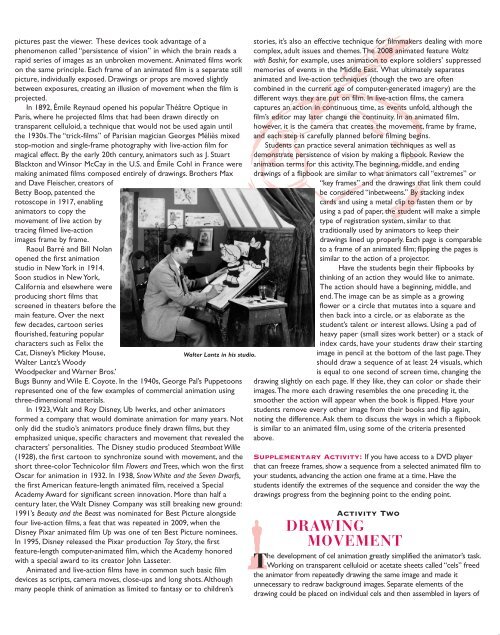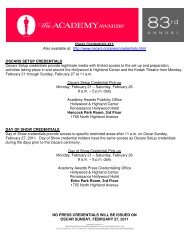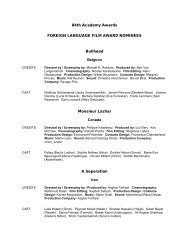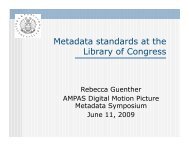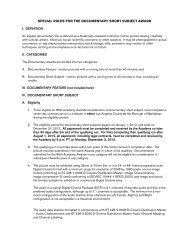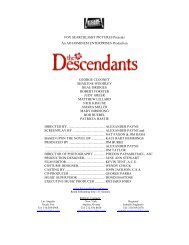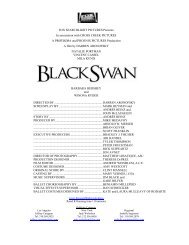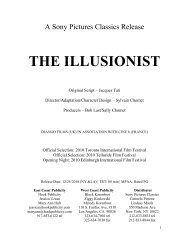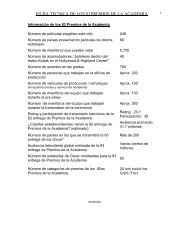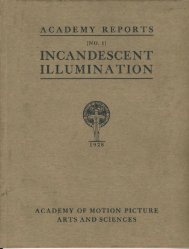CREATING MOVEMENT FRAME by FRAME - Academy of Motion ...
CREATING MOVEMENT FRAME by FRAME - Academy of Motion ...
CREATING MOVEMENT FRAME by FRAME - Academy of Motion ...
Create successful ePaper yourself
Turn your PDF publications into a flip-book with our unique Google optimized e-Paper software.
pictures past the viewer. These devices took advantage <strong>of</strong> a<br />
phenomenon called “persistence <strong>of</strong> vision” in which the brain reads a<br />
rapid series <strong>of</strong> images as an unbroken movement. Animated films work<br />
on the same principle. Each frame <strong>of</strong> an animated film is a separate still<br />
picture, individually exposed. Drawings or props are moved slightly<br />
between exposures, creating an illusion <strong>of</strong> movement when the film is<br />
projected.<br />
In 1892, Émile Reynaud opened his popular Théâtre Optique in<br />
Paris, where he projected films that had been drawn directly on<br />
transparent celluloid, a technique that would not be used again until<br />
the 1930s.The “trick-films” <strong>of</strong> Parisian magician Georges Méliès mixed<br />
stop-motion and single-frame photography with live-action film for<br />
magical effect. By the early 20th century, animators such as J. Stuart<br />
Blackton and Winsor McCay in the U.S. and Émile Cohl in France were<br />
making animated films composed entirely <strong>of</strong> drawings. Brothers Max<br />
and Dave Fleischer, creators <strong>of</strong><br />
Betty Boop, patented the<br />
rotoscope in 1917, enabling<br />
animators to copy the<br />
movement <strong>of</strong> live action <strong>by</strong><br />
tracing filmed live-action<br />
images frame <strong>by</strong> frame.<br />
Raoul Barré and Bill Nolan<br />
opened the first animation<br />
studio in New York in 1914.<br />
Soon studios in New York,<br />
California and elsewhere were<br />
producing short films that<br />
screened in theaters before the<br />
main feature. Over the next<br />
few decades, cartoon series<br />
flourished, featuring popular<br />
characters such as Felix the<br />
Cat, Disney’s Mickey Mouse,<br />
Walter Lantz in his studio.<br />
Walter Lantz’s Woody<br />
Woodpecker and Warner Bros.’<br />
Bugs Bunny and Wile E. Coyote. In the 1940s, George Pal’s Puppetoons<br />
represented one <strong>of</strong> the few examples <strong>of</strong> commercial animation using<br />
three-dimensional materials.<br />
In 1923,Walt and Roy Disney, Ub Iwerks, and other animators<br />
formed a company that would dominate animation for many years. Not<br />
only did the studio’s animators produce finely drawn films, but they<br />
emphasized unique, specific characters and movement that revealed the<br />
characters’ personalities. The Disney studio produced Steamboat Willie<br />
(1928), the first cartoon to synchronize sound with movement, and the<br />
short three-color Technicolor film Flowers and Trees, which won the first<br />
Oscar for animation in 1932. In 1938, Snow White and the Seven Dwarfs,<br />
the first American feature-length animated film, received a Special<br />
<strong>Academy</strong> Award for significant screen innovation. More than half a<br />
century later, the Walt Disney Company was still breaking new ground:<br />
1991’s Beauty and the Beast was nominated for Best Picture alongside<br />
four live-action films, a feat that was repeated in 2009, when the<br />
Disney Pixar animated film Up was one <strong>of</strong> ten Best Picture nominees.<br />
In 1995, Disney released the Pixar production Toy Story, the first<br />
feature-length computer-animated film, which the <strong>Academy</strong> honored<br />
with a special award to its creator John Lasseter.<br />
Animated and live-action films have in common such basic film<br />
devices as scripts, camera moves, close-ups and long shots.Although<br />
many people think <strong>of</strong> animation as limited to fantasy or to children’s<br />
stories, it’s also an effective technique for filmmakers dealing with more<br />
complex, adult issues and themes.The 2008 animated feature Waltz<br />
with Bashir, for example, uses animation to explore soldiers’ suppressed<br />
memories <strong>of</strong> events in the Middle East. What ultimately separates<br />
animated and live-action techniques (though the two are <strong>of</strong>ten<br />
combined in the current age <strong>of</strong> computer-generated imagery) are the<br />
different ways they are put on film. In live-action films, the camera<br />
captures an action in continuous time, as events unfold, although the<br />
film’s editor may later change the continuity. In an animated film,<br />
however, it is the camera that creates the movement, frame <strong>by</strong> frame,<br />
and each step is carefully planned before filming begins.<br />
Students can practice several animation techniques as well as<br />
demonstrate persistence <strong>of</strong> vision <strong>by</strong> making a flipbook. Review the<br />
animation terms for this activity.The beginning, middle, and ending<br />
drawings <strong>of</strong> a flipbook are similar to what animators call “extremes” or<br />
“key frames” and the drawings that link them could<br />
be considered “inbetweens.” By stacking index<br />
cards and using a metal clip to fasten them or <strong>by</strong><br />
using a pad <strong>of</strong> paper, the student will make a simple<br />
type <strong>of</strong> registration system, similar to that<br />
traditionally used <strong>by</strong> animators to keep their<br />
drawings lined up properly. Each page is comparable<br />
to a frame <strong>of</strong> an animated film; flipping the pages is<br />
similar to the action <strong>of</strong> a projector.<br />
Have the students begin their flipbooks <strong>by</strong><br />
thinking <strong>of</strong> an action they would like to animate.<br />
The action should have a beginning, middle, and<br />
end.The image can be as simple as a growing<br />
flower or a circle that mutates into a square and<br />
then back into a circle, or as elaborate as the<br />
student’s talent or interest allows. Using a pad <strong>of</strong><br />
heavy paper (small sizes work better) or a stack <strong>of</strong><br />
index cards, have your students draw their starting<br />
image in pencil at the bottom <strong>of</strong> the last page.They<br />
should draw a sequence <strong>of</strong> at least 24 visuals, which<br />
is equal to one second <strong>of</strong> screen time, changing the<br />
drawing slightly on each page. If they like, they can color or shade their<br />
images.The more each drawing resembles the one preceding it, the<br />
smoother the action will appear when the book is flipped. Have your<br />
students remove every other image from their books and flip again,<br />
noting the difference.Ask them to discuss the ways in which a flipbook<br />
is similar to an animated film, using some <strong>of</strong> the criteria presented<br />
above.<br />
Supplementary Activity: If you have access to a DVD player<br />
that can freeze frames, show a sequence from a selected animated film to<br />
your students, advancing the action one frame at a time. Have the<br />
students identify the extremes <strong>of</strong> the sequence and consider the way the<br />
drawings progress from the beginning point to the ending point.<br />
Activity Two<br />
DRAWING<br />
<strong>MOVEMENT</strong><br />
The development <strong>of</strong> cel animation greatly simplified the animator’s task.<br />
Working on transparent celluloid or acetate sheets called “cels” freed<br />
the animator from repeatedly drawing the same image and made it<br />
unnecessary to redraw background images. Separate elements <strong>of</strong> the<br />
drawing could be placed on individual cels and then assembled in layers <strong>of</strong>


